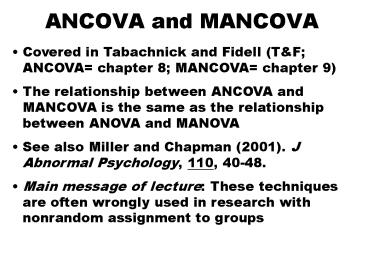ANCOVA and MANCOVA - PowerPoint PPT Presentation
1 / 17
Title:
ANCOVA and MANCOVA
Description:
The relationship between ANCOVA and MANCOVA is the same as the relationship ... lecture: These techniques are often wrongly used in research with nonrandom ... – PowerPoint PPT presentation
Number of Views:2510
Avg rating:3.0/5.0
Title: ANCOVA and MANCOVA
1
ANCOVA and MANCOVA
- Covered in Tabachnick and Fidell (TF ANCOVA
chapter 8 MANCOVA chapter 9) - The relationship between ANCOVA and MANCOVA is
the same as the relationship between ANOVA and
MANOVA - See also Miller and Chapman (2001). J Abnormal
Psychology, 110, 40-48. - Main message of lecture These techniques are
often wrongly used in research with nonrandom
assignment to groups
2
(M)ANCOVA
- 3 Uses (statistical operations are same)
- To increase power by reducing error term in
experimental work (with random assignment to
groups) - To adjust for mismatch on nuisance variable in
nonexperimental work (N.B. this is the tricky
case) - Stepdown analyses to follow-up MANOVA (as
discussed in lecture on MANOVA)
3
General Points
- ANCOVA can be used with all types of ANOVA
designs - Can even have a changing covariate in repeated
measures designs (but not in SPSS) - ANCOVA equivalent to multiple regression
- How does ANCOVA reduce the error term? (see Fig
8.1 in TF)
4
Types of Research Question
- ANCOVA addresses the same questions about IVs
that ANOVA does (e.g. main and interaction
effects, specific comparisons and contrasts etc.) - The effects of IVs are assessed holding
covariates constant (i.e., treating each subject
as if they scored at the mean for the covariate) - Provides test of significance for the regression
of the covariate(s) on the DV ignoring group
effects
5
Theoretical Issues Choice of Covariates
- Ideal is small number of orthogonal covariates,
each correlated with the DV - This gives maximum adjustment of the DV for
minimum reduction in df for the error term (each
covariate reduces error df by 1)
6
Theoretical Issues Random vs. Nonrandom
Assignment
- In random assignment (experimental) designs,
group differences in covariate will be due to
chance (as long as covariates measured before
assignment) - With nonrandom assignment (common in psychology)
covariate differences may reflect meaningful
substantive differences related to group
membership
7
Why is ANCOVA invalid when groups differ on
covariate?
Grp(res) Grp with Cov removed
GRP
Cov
Cov
GRP
DV
DV
- Non-random assignment
Random assignment
8
Why is ANCOVA invalid when groups differ on
covariate?
- ANCOVA looks at relationship between DV and
Grp(res) - Dont know what Grp(res) represents when Cov and
Grp are related - ANCOVA may remove part of treatment effect or
produce a spurious effect - Grp variable altered so that it may no longer
measure what it was intended to measure
9
ILLUSTRATIONS OF INVALID USE OF ANCOVA
10
Conceptual IllustrationsLords Example
- Do boys or girls (IVgender) end up weighing more
(DVfinal weight) when following a specific diet,
after correcting for initial weight (covariate)
differences between boys and girls? - Problem of regression to the mean for matched
weight gender groups
11
Conceptual IllustrationsMiller Chapmans
Example
- Would six and eight year olds (IVage groups)
differ in weight (DV) if they did not differ in
height (covariate)? - One cannot equate younger and older children in
height because height is an intrinsic part of the
age difference.
12
Typical Research Examples
- Comparing depressed participants vs. nondepressed
controls using trait anxiety score as a covariate - Comparing schizophrenic participants vs. healthy
controls on memory performance using IQ as a
covariate
13
Can ANCOVA Ever be Valid with Group Differences
on Covariate?
- If group differences arose by chance (e.g. in
experiments with random assignment) - Overall and Woodward (77) if group could NOT
have caused the covariate differences - As a useful means of exploring the dataset and
clarifying the relationships between the variables
14
Alternatives to ANCOVA
- Incorporate the covariate as a substantive factor
into the analysis - Rosenbaums propensity score method
- Extended regression equation in the comparison
group for the DV and the covariate analyse
residual scores for other group.
15
ANCOVA Practical Issues
- Absence of outliers (both univariate and
multivariate outliers among DVs and covariates) - Eliminate highly correlated covariates
(multicollinearity and singularity) - Homogeneity of variance for DV and covariates
- Relationships between DV and covariates, and
between covariates, should be linear
16
ANCOVA Extra Assumptions
- Homogeneity of Regression (see Fig 8.2 in TF)
- How to test this in SPSS?
- Reliability of covariates needs to be high in
nonexperimental research (gt0.8) in experimental
work unreliability just leads to conservative
reduction in error
17
Testing for Homogeneity of Regression
- Include covariate x IV interaction term(s) in the
model - If these are significant then there is
heterogeneity of regression and ANCOVA is
inappropriate - In SPSS, the Model button allows you to specify
the model - Note a full factorial model (SPSS default)
does not include interactions between covariates
and IVs

